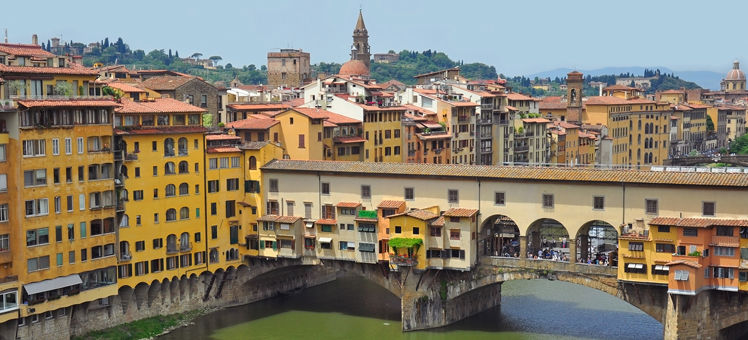 Known as the cradle of the Renaissance, Florence is widely regarded as Italy's artistic capital. Within the ancient medieval walls that enclose the historic center, the winding streets are dotted with as historic monuments and influential works of art. Walk the streets and you'll encounter awe-inspiring art - Michelangelo's David, Bartolomeo Ammanati's Fountain of Neptune - as well as great places to eat and drink.
Known as the cradle of the Renaissance, Florence is widely regarded as Italy's artistic capital. Within the ancient medieval walls that enclose the historic center, the winding streets are dotted with as historic monuments and influential works of art. Walk the streets and you'll encounter awe-inspiring art - Michelangelo's David, Bartolomeo Ammanati's Fountain of Neptune - as well as great places to eat and drink.
Florence boasts a typical Mediterranean climate characterized by hot summers with some light rainfall, and cool, damp winters. Easter usually kicks off high season, with several traditional events surrounding the religious holiday. The season runs through mid-July, then picks up again in September and October. The period from mid-July to late August is considered summer low season in major Italian cities, since this is when locals take their summer holidays. During this time, hotels will lower their rates, but be prepared for some stifling temperatures.
Art is definitely the main draw in Florence, with visits to the Uffizi Gallery, home to a vast collection of international and Florentine art, and Palazzo Pitti, the former residence of the Medici family, are a must. You can stroll through the historic center and marvel at Santa Maria del Fiore Cathedral's impressive dome, also simply called Il Duomo. Then make a beeline for Palazzo Vecchio town hall, where you'll find Florence's most recognizable citizen: Michelangelo's David (although the statue that's currently at the site is a replica; the original is housed at the Galleria dell'Accademia).
Florence's airport, Peretola, is only 4 km from the city, and reaching the center is either a 15-minute taxi ride or 20 minutes on the shuttle bus. Although you can find direct flights from many European cities, it might be difficult from intercontinental locations. In this case, you're more likely to fly into Pisa, which is 88 km away, and take the train to Florence. The historic center is quite small, and walking is your best bet to fully explore everything there is to see. Or you can hop on a city bus and travel Florence like the locals do.
Like much of the country's cuisine, Florentine food is largely derived from peasant eating, or what the Italians call la cucina povera, which relies on fresh, local, and simple ingredients. The majority of dishes are based on meat - in fact, bistecca fiorentina (Florentine steak) is a staple in most restaurants. Tuscan bread is saltless, which makes it a robust and satisfying addition to many dishes, like the typical ribollita soup and panzanella salad. Of course, this being Tuscany, you'll be able to wash down your food with some of the country's most renowned wines, including Chianti and Sangiovese.
Florence is a progressive city on most fronts, with all races, cultures, and sexualities mixing freely and openly. Fashion is an important component to Florentine life - indeed, Gucci, Salvatore Ferragamo, and Roberto Cavalli are based here - and locals take pride in their dress, especially in wearing good quality leather shoes. They are particularly conscious of their attire on Sundays, when most people head outside for their traditional passeggiata (evening stroll). Tipping in restaurants is not customary, as it's usually included, and will appear on your bill as "servizio" or "coperto."